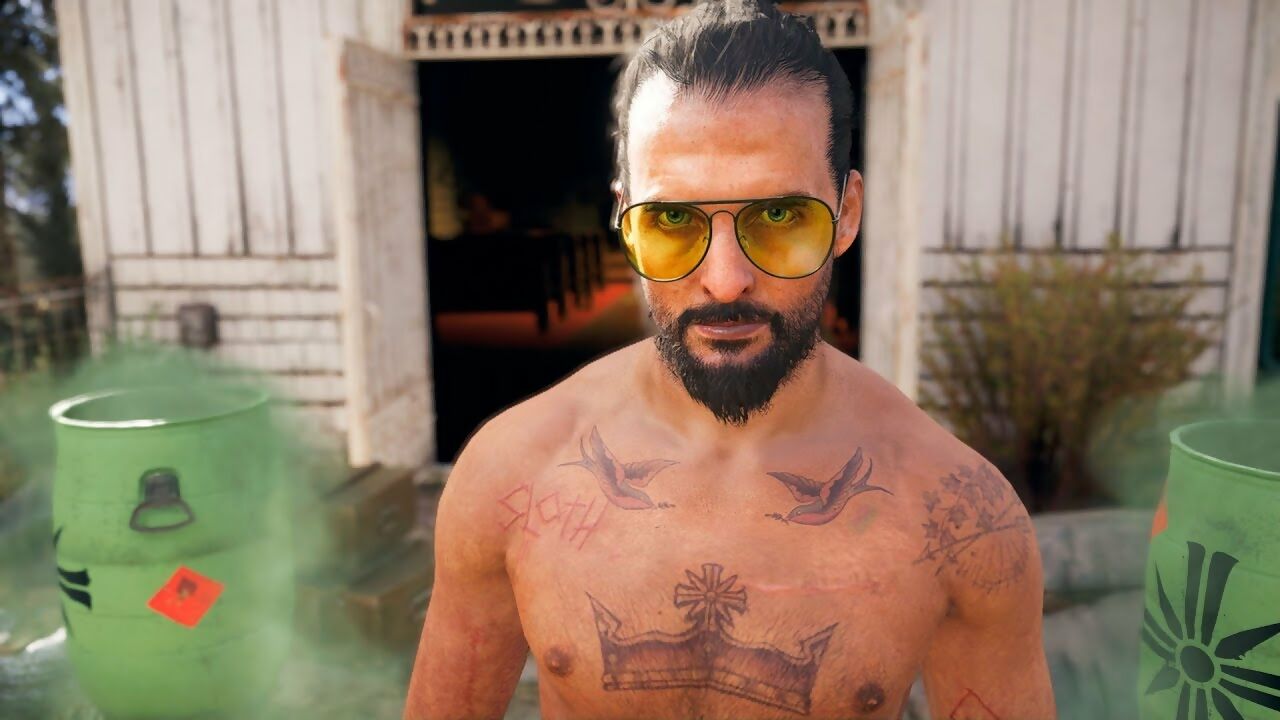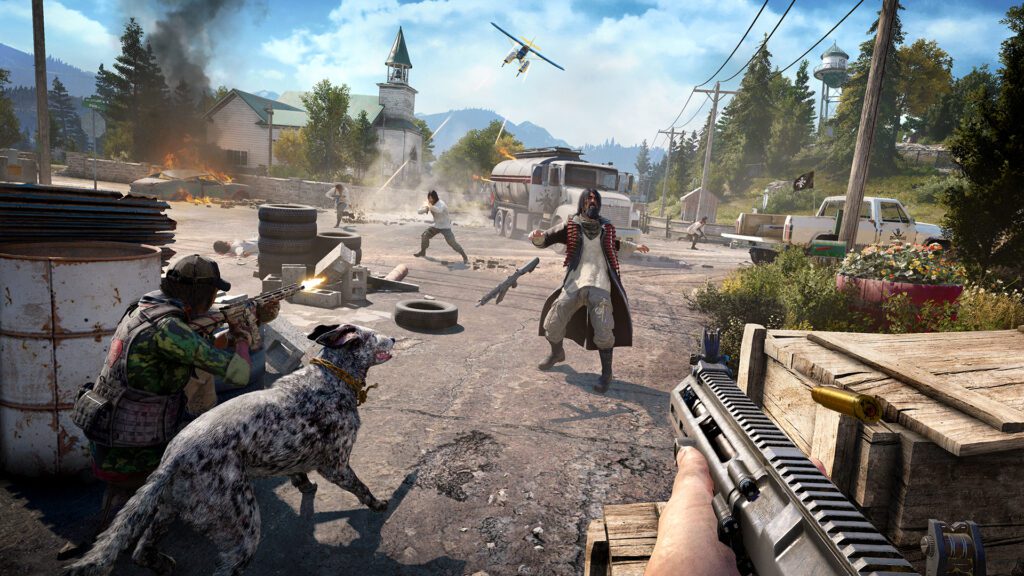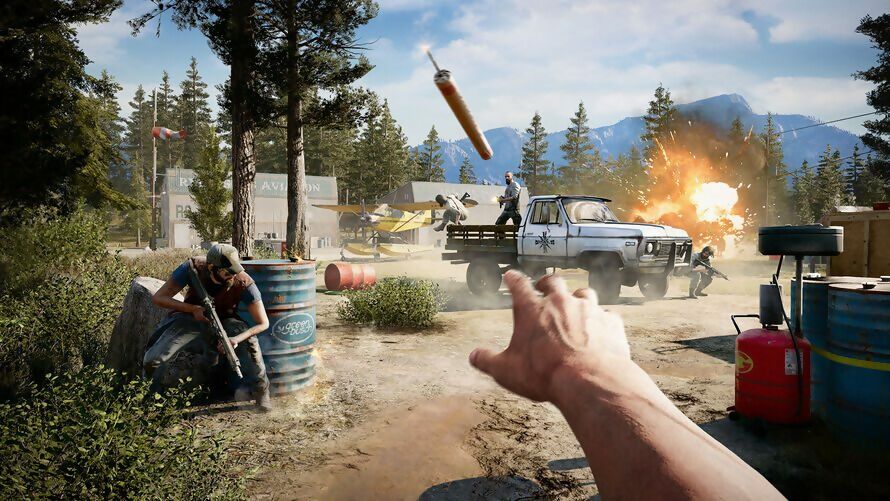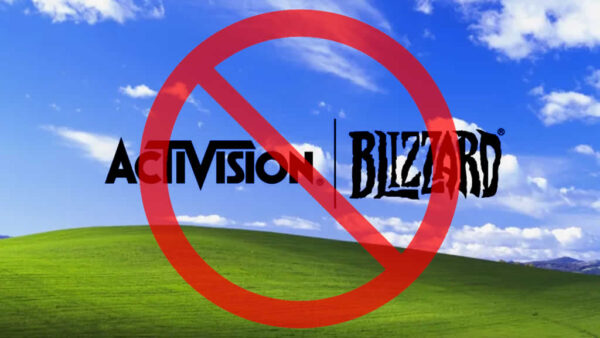
With inevitable spoilers, we explore Far Cry 5 and its explosive ending – and how it jars with the action in the game itself…
Five years after its original release, Far Cry 5 still holds up as a lively, systemically complex open-world sandbox. And, thanks to Ubisoft’s current-gen update, which allows it to run at a silky 60 frames-per-second on the latest consoles, it certainly looks better than ever. But while Far Cry 5 can be played as a breezy, upbeat action adventure in the mould of a 1980s TV series – something we wrote about last month – there’s the constant feeling that it’s a game with a split personality.
Its opening scene, in which your wordless Deputy attempts to arrest religious cult leader Joseph Seed, crackles with sustained, dramatic tension. Then you get into the meat of the game itself, and you find yourself leaning out of a moving truck and throwing sticks of dynamite at angry religious acolytes.
Depending on where you go next, you might acquire a furry sidekick named Cheeseburger, a diabetic bear who’ll loyally wade into combat and tear bearded enemies limb from limb. There are also goofy mini-games and challenges, set for you by a stuntman named Clutch Nixon. Each one is prefaced with a bizarre clip of an eagle flying out of an explosion straight at the camera. The eagle itself subsequently explodes.
These likeably absurd action set-pieces are contrasted with cut-scenes that help move the plot along. Invariably, they see you, restrained in some way, powerlessly watching as one of Seed’s three lieutenants regales you with a deathly-serious, apocalyptic monologue that seems to go on for an eternity.
The result is a game that swerves unnervingly between the deadly serious and the outright ridiculous; even the Deputy’s habit of constantly getting drugged or incapacitated in some way, waking up tied to a chair, and then escaping the cult’s clutches, begins to feel self-parodic after a while.
‘Ludo-narrative dissonance’ is a phrase that often comes up in gaming circles. It’s the term that most obviously applies to a character like Nathan Drake, a likeable, fairly ordinary guy in tight jeans who effortlessly slaughters hundreds of human beings throughout his adventures, then goes back to being affable and certainly not psychotic during his cut-scenes. Far Cry 5 is the opposite of this: the player’s character feels of a piece with the surrounding world, but the overarching plot feels divided against itself. The Deputy is never depicted as an entirely likeable or even trustworthy character. The assorted factions of freedom fighters milling around Hope County are glad he’s there, but that’s because he’s a one-man army who’s fighting for their cause.
Joseph Seed’s lieutenants, on the other hand, constantly question the Deputy’s character and the validity of his mission – often in yet another long monologue shortly before they breathe their last. Through these characters, the game seems to actively question the player’s morality, even as it gradually ushers you into a collision course with John Seed. The only way to avoid this is to select one of the ‘bad endings’ at the beginning or end of the campaign.
The suggestion that the player’s character isn’t exactly a good guy has popped up in the Far Cry franchise before – Far Cry 2 springs to mind – and it’s an interesting notion to explore in a video game. Shadow of the Colossus, for example, had players slaying terrifying yet dignified giant creatures, and there was a constant pang throughout the game that what you were doing was wrong.
In Far Cry 5, however, the actions of Joseph Seed’s acolytes constantly suggest that you’re right to embark on your bullet-strewn mission. Everywhere you look, members of Eden’s Gate are terrorising the population, leaving bodies strung up by the side of the road and water supplies poisoned with their patented drug, Bliss. Far Cry 5 might philosophically suggest that it’s better to walk away than intervene, but to do so would be to leave an entire state in the grip of a bunch of bloodthirsty maniacs.

Credit: Ubisoft.
All of which brings us to that Far Cry 5 ending. Throughout, Joseph Seed and his ‘family’ warn of a coming apocalypse. As you finally shatter Seed’s regime and head to his church to make a second attempt at arresting him, a flash tears the sky in two and a mushroom cloud appears on the horizon. During the attempt to flee the resulting apocalypse, your vehicle crashes, instantly killing several of the freedom fighters you got to know in Far Cry 5’s lengthy campaign. The view then cuts to a bunker where the Deputy is once again tied down. Joseph Seed’s here, delivering what is essentially a long and florid ‘I told you so’.
And that’s it. Roll credits.
After dozens of hours in the company of Far Cry 5’s roster of characters, and a similar length of time taking out enemy strongholds, blowing up shrines, and escaping from Seed’s bunkers for the umpteenth time, the campaign ends with your total failure. All the people you met (and on occasions, even liked) are presumably dead. Your actions, your victories, the thousands of dollars you amassed and didn’t spend just in case you needed the cash later – all meant nothing. Also: the swivel-eyed cult leader was right all along.
It’s hard to know exactly what to make of the thinking behind it all. With his aviator glasses and penchant for building armies, Joseph Seed bears more than a passing resemblance to real-world doomsday cult leader, David Koresh. Koresh died when his compound in Waco, Texas burned to the ground following a bloody stand-off with ATF agents in the spring of 1993. Far Cry 5 was released in March 2018, almost exactly 25 years after the Waco siege.
Ubisoft would probably say that the resemblance and timing are coincidences, and maybe they are. But I’d argue the parallels are a further sign of a game that flirts with weighty themes but then nervously backs away from them. When Far Cry 5 came out, it was criticised by some for not fully engaging with the themes raised by its own setting – America’s cocktail of religion and widespread gun ownership; a country divided under then-president Donald Trump, and so on.

Credit: Ubisoft.
Perplexingly, Far Cry 5 doesn’t – and perhaps can’t – ignore these entirely. There are people spouting conspiracy theories all over Hope County, and lines like “Not every problem can be solved with a bullet” at least hint at some deeper thinking, even if they are disproven a few seconds later when you solve yet another problem with – you guessed it – a bullet.
In seeming fear of causing further controversy, Far Cry 5’s creators back away from giving any of this further analysis, and instead let the player gleefully run riot in a string of missions and set-pieces that, again, resemble a certain 1980s TV show. All of which would be fine were it not for that ending, which pulls the rug out from under all that feel-good action. It’s unexpected, certainly – though curiously reminiscent of Kevin Smith’s 2011 indie thriller, Red State – but at the same time deeply unsatisfying.
(Interestingly, 2019 spin-off Far Cry: New Dawn, which takes place 17 years after Far Cry 5 and its apocalypse, seems keen to redress the bleak tone of its forebear’s ending. Some non-player characters from that game are revealed to have survived.)
Far Cry 5 doesn’t have the confidence to interrogate its own subject to the extent that, say, Spec Ops: The Line did with its Apocalypse Now-like take on the futility of war. Instead, the conclusion serves to wipe the smile off the player’s face, but without giving them anything particularly thought-provoking to chew on as the screen fades to black. So much of Far Cry 5 was about clawing power back from a violent regime; it was about forging alliances and creating new communities out of the ashes of the old. In a nuclear flash, the Far Cry 5 ending wiped away that positivity for a final scene of ill-judged nihilism.
To paraphrase T.S. Elliot, this is the way Far Cry 5’s world ends: with both a bang and a whimper.





